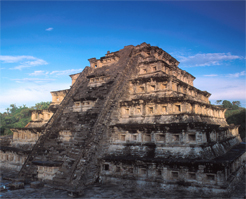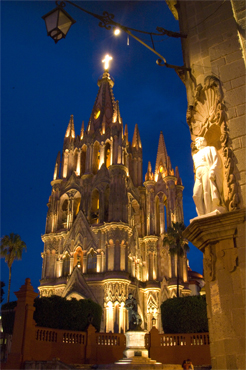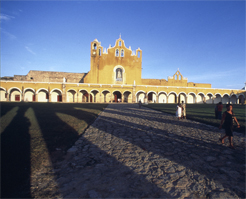Welcome to Mexico / Bienvenido a Mexico



Telephone:
E:
 From the Pacific to the Caribbean, the desert to the rain forest and the central plateau to the snow capped volcanoes; Mexico’s spectrum of light, colour and landscapes showcases the deep rooted unity of a nation adapting to modernity and proud of its cultural heritage. Few countries are in a position to offer travellers such a variety of things to do and see from the gastronomy, beaches, archaeological sites, history, folklore, culture and art. With this in mind, three words define Mexico’s tourist product: Hospitality, Culture and Diversity.
From the Pacific to the Caribbean, the desert to the rain forest and the central plateau to the snow capped volcanoes; Mexico’s spectrum of light, colour and landscapes showcases the deep rooted unity of a nation adapting to modernity and proud of its cultural heritage. Few countries are in a position to offer travellers such a variety of things to do and see from the gastronomy, beaches, archaeological sites, history, folklore, culture and art. With this in mind, three words define Mexico’s tourist product: Hospitality, Culture and Diversity.
The quality of Mexico’s beaches is well known worldwide. Heavenly beaches line Mexico’s coast in resorts such as Cancun, Los Cabos, Bahias de Huatulco, Acapulco, Puerto Vallarta, Cozumel and the white sand beaches of the Riviera Maya. Furthermore all make ideal playgrounds for practising water sports such as fishing, diving, wind surfing, water skiing and many more.
Aside from beach life, there are other reasons to visit Mexico; the country’s colonial cities allow visitors an insight into the history of Mexico. Mexico City, Queretaro, San Miguel de Allende, Guanajuato, San Luis Potosí, Zacatecas are truly Mexican cities each one display a strong historic economic, artistic and cultural legacy. Traces of Mexico or New Spain as it was during Spain’s three centuries of rule, can be found at Aguascalientes, Michoacan, Puebla, Oaxaca and Mexico City’s Historic Centre.
Mexico’s heritage is not only made up of colonial treasures and stunning beaches but also archaeological sites. So far 174 archaeological sites have been discovered and are open to the public. Two of the most known ancient cultures of Mexico are the Aztecs of central Mexico and the Zapotecs from the Pacific coast. The Olmecs, in the Gulf of Mexico, were the first civilisation in Mesoamerica and the Mayan, in the Yucatan Peninsula, has been identified as one the most advanced civilisations.
There are currently 29 World Heritage Sites in Mexico, 25 of them are cultural sites and four belong to the world natural heritage; with this the country has the most UNESCO Heritage Sites in the whole of Latin America.
Mexico has over 150 Natural Protected Areas - national parks, marine parks, areas of natural beauty and Biosphere Reserves. Nature-based tourism is an activity that has gained popularity worldwide and Mexico has become an important destination for nature lovers from around the world. In the recently published booked Mexico’s Biodiversity Mexico ranks fourth worldwide for its biodiversity.
Mexico also offers first-class cultural and recreational activities such as marine theme parks (Xcaret or Xel-Há), zoos and museums as well as world class haciendas and glamorous spas are just a few of the attractions. Furthermore, Mexico possesses a number of alluring towns and villages. Meanwhile 35 of them belong to the programme “Pueblos Mágicos” (magical towns) that attract the visitor in a “magical” way through architecture, history, gastronomy and typically Mexican traditions and atmosphere. These are magical towns in the present (dating 2009): Huamantla in Tlaxcala; Real de Asientos in Aguascalientes; Pátzcuaro, Tlalpujahua and Cuitzeo in Michoacán; Álamos in Sonora; Cosalá in Sinaloa; Tequila, Tapalpa, Mazamitla in Jalisco; Valle de Bravo and Tepotzotlán in the state of Mexiko; Huasca de Ocampo and Real del Monte in Hidalgo; Dolores Hidalgo and San Miguel de Allende in Guanajuato; Comala in Colima; Izamal in Yucatán; Santiago in Nuevo León; Taxco in Guerrero; Tepotzlán in Morelos, Mexcaltitlán in Nayarit; Cuetzalan in Puebla; Real de Catorce in San Luis Potosí; San Cristóbal de las Casas in Chiapas; Parras de la Fuente in Coahuila; Bernal in Querétaro; Coatepec and Papantla in Veracruz; Todos Santos in Baja California Sur, Bacalar in Quintana Roo as well as Jerez in Zacatecas.
Mexico is also a favourite amongst cruise travellers; nearly half the world’s cruise ship passengers arrive in Mexico.
Mexico City is a living breathing treasure trove of art and culture. The first settlers arrived here over 3,000 years ago and it is now the oldest city in the Western Hemisphere, as well as one of the largest.
Despite Mexico’s natural and cultural heritage it is the people, their warmth and friendliness and the local traditions that continue to attract visitors to Mexico.
